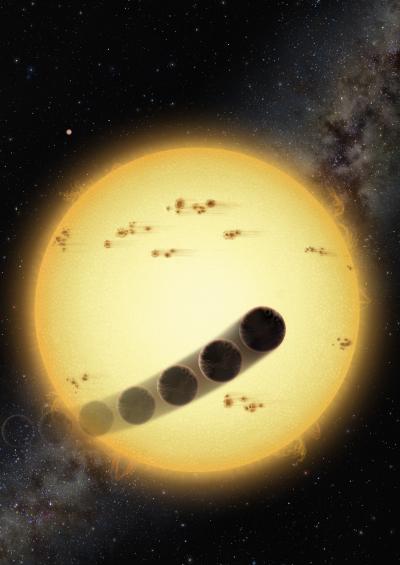The proximity of these huge planets to their stars have made theoreticians and their flipped orbits have made theoreticians want to explain it - numerical models to the rescue. Using large-scale computer simulations, Frederic A. Rasio, a theoretical astrophysicist at Northwestern University and his team say they are the first to model how a hot Jupiter's orbit can flip and go in the direction opposite to the star's spin.
Gravitational perturbations by a much more distant planet result in the hot Jupiter having both a "wrong way" and a very close orbit.
"Once you get more than one planet, the planets perturb each other gravitationally," Rasio said. "This becomes interesting because that means whatever orbit they were formed on isn't necessarily the orbit they will stay on forever. These mutual perturbations can change the orbits, as we see in these extrasolar systems."
The physics the research team used to solve the problem is basically orbital mechanics, Rasio said, the same kind of physics NASA uses to send satellites around the solar system.

A transiting giant planet orbits very close to the star and in a direction opposite to the stellar rotation. This peculiar configuration results from gravitational perturbations by another much more distant planet (upper left). Credit: Lynette Cook
"We had thought our solar system was typical in the universe, but from day one everything has looked weird in the extrasolar planetary systems," Rasio said. "That makes us the odd ball really. Learning about these other systems provides a context for how special our system is. We certainly seem to live in a special place."
In their model, the researchers assume a star similar to the sun, and a system with two planets. The inner planet is a gas giant similar to Jupiter, and initially it is far from the star, where Jupiter-type planets are thought to form. The outer planet is also fairly large and is farther from the star than the first planet. It interacts with the inner planet, perturbing it and shaking up the system.
The effects on the inner planet are weak but build up over a very long period of time, resulting in two significant changes in the system: the inner gas giant orbits very close to the star and its orbit is in the opposite direction of the central star's spin. The changes occur, according to the model, because the two orbits are exchanging angular momentum, and the inner one loses energy via strong tides.
The gravitational coupling between the two planets causes the inner planet to go into an eccentric, needle-shaped orbit. It has to lose a lot of angular momentum, which it does by dumping it onto the outer planet. The inner planet's orbit gradually shrinks because energy is dissipated through tides, pulling in close to the star and producing a hot Jupiter. In the process, the orbit of the planet can flip.
Only about a quarter of astronomers' observations of these hot Jupiter systems show flipped orbits.
"Doing the calculations was not obvious or easy," Rasio said, "Some of the approximations used by others in the past were really not quite right. We were doing it right for the first time in 50 years, thanks in large part to the persistence of Smadar."
Smadar Naoz, a postdoctoral fellow at Northwestern, is first author of the paper.
"It takes a smart, young person who first can do the calculations on paper and develop a full mathematical model and then turn it into a computer program that solves the equations," Rasio added. "This is the only way we can produce real numbers to compare to the actual measurements taken by astronomers."
"Hot Jupiters From Secular Planet–Planet Interactions", Nature, May 12th






Comments